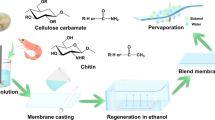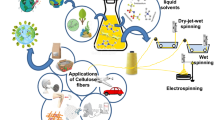Abstract
The molecular weight of ultra-high molecular weight polyethylene (UHMWPE) fibers is severely decreased compared with raw materials due to high temperature and strong shearing in the dissolving process. In this study, we reported a novel method to assist the dissolving of UHMWPE in paraffin oil without severe degradation in order to improve the tensile strength of resultant fibers. UHMWPE fibers with relatively high molecular weight and more excellent disentanglement effect were prepared by gel-spinning with UHMWPE suspension treated with supercritical carbon dioxide (SC-CO2). The dynamic thermomechanical, mechanical and crystalline properties of UHMWPE extracted fibers and drawn fibers were researched comprehensively. UHMWPE extracted fibers obtained after SC-CO2 treatment display a higher molecular weight. More importantly, it is clear that the disentanglement of UHMWPE gel fibers gained by processing SC-CO2 has been significantly promoted compared with that without SC-CO2 treatment from dynamic thermomechanical and rheological results, which could also be demonstrated from the cross-sectional morphology of UHMWPE extracted fibers. Furthermore, the tensile strength of UHMWPE fibers prepared through SC-CO2 treating is able to attain 30.11 cN/dtex, increased by 10.3% in comparison to UHMWPE fibers gained without assistance of SC-CO2. Beyond that, the thermal behavior and crystallization performance of UHMWPE extracted fibers and drawn fibers acquired by way of SC-CO2 treatment have also been enhanced.










Similar content being viewed by others
References
Liu X, Wang K. Interfacial microstructure and properties between epoxy resin and novel organic hybrid graphene oxide modification ultra high molecular weight polyethylene fiber. Polym. 2020; 197.
Wang H, Quan J, Wang X, Yu J, Zhu J, Wang Y, Hu Z. The effect of shrinkage on the structure and properties of ultra-high molecular weight polyethylene fibers with different concentration. J Appl Polym Sci 2020;138:50198.
Huang W, Wang Y, Xia Y. Statistical dynamic tensile strength of UHMWPE-fibers. Polym 2004;45:3729.
Kartal GE, Sarıışık AM. Modifying of UHMWPE fishing nets with layer-by-layer deposition method for antifouling properties. J Coat Technol Res 2020;18:163.
McDaniel PB, Strawhecker KE, Deitzel JM, Gillespie JW. Nanoscale interfibrillar adhesion in UHMWPE fibers. Journal of Polymer Science Part B: Polym Phys 2018;56:391.
Lei T, Huang KS, Kuo MC, Runt J, Yeh JT. Utilization of supercritical CO2 as a processing aid for preparation of ultrahigh molecular weight polyethylene/functionalized activated nanocarbon fibers. Polym Eng Sci 2019;59:1462.
Aminian A, ZareNezhad B. A generalized neural network model for the VLE of supercritical carbon dioxide fluid extraction of fatty oils. Fuel. 2020; 282.
Arumugham T, K R, Hasan SW, Show PL, Rinklebe J, Banat F. Supercritical carbon dioxide extraction of plant phytochemicals for biological and environmental applications—a review. Chemosphere. 2021; 271, 129525.
Bezerra FWF, Salazar MdLAR, Freitas LC, de Oliveira MS, dos Santos IRC, Dias MNC, Gomes-Leal W, Andrade EHdA, Ferreira GC, Carvalho RNd. Chemical composition, antioxidant activity, anti-inflammatory and neuroprotective effect of Croton matourensis Aubl. Leaves extracts obtained by supercritical CO2. J Supercrit Fluids. 2020; 165.
Mohd‐Nasir H, Putra NR, Chuo SC, Daud NM, Hartati H, Bakeri N, Ruslan MSH, Mohd‐Setapar SH, Ahmad A, Md Salleh L. Optimization of the supercritical carbon dioxide extraction of Quercus infectoria galls extracts and its bioactivities. J Food Process Preserv. 2020; 45.
Szliszka E, Czuba ZP, Domino M, Mazur B, Zydowicz G, Krol W. Ethanolic extract of propolis (EEP) enhances the apoptosis- inducing potential of TRAIL in cancer cells. Molecules 2009;14:738.
Vasquez WV, Hernández DM, del Hierro JN, Martin D, Cano MP, Fornari T. Supercritical carbon dioxide extraction of oil and minor lipid compounds of cake byproduct from Brazil nut (Bertholletia excelsa) beverage production. J Supercrit Fluids. 2021; 171.
Guo H, Meador MA, McCorkle L, Quade DJ, Guo J, Hamilton B, Cakmak M. Tailoring properties of cross-linked polyimide aerogels for better moisture resistance, flexibility, and strength. ACS Appl Mater Interfaces 2012;4:5422.
Li X, Wang J, Zhao Y, Zhang X. Template-free self-assembly of fluorine-free hydrophobic polyimide aerogels with lotus or petal effect. ACS Appl Mater Interfaces 2018;10:16901.
Meador MA, Wright S, Sandberg A, Nguyen BN, Van Keuls FW, Mueller CH, Rodriguez-Solis R, Miranda FA. Low dielectric polyimide aerogels as substrates for lightweight patch antennas. ACS Appl Mater Interfaces 2012;4:6346.
Meador MAB, Agnello M, McCorkle L, Vivod SL, Wilmoth N. Moisture-resistant polyimide aerogels containing propylene oxide links in the backbone. ACS Appl Mater Interfaces 2016;8:29073.
Qiao S, Kang S, Hu Z, Yu J, Wang Y, Zhu J. Moisture-resistance, mechanical and thermal properties of polyimide aerogels. J Porous Mater 2019;27:237.
Qiao S, Zhang H, Kang S, Quan J, Hu Z, Yu J, Wang Y, Zhu J. Hydrophobic, Pore‐Tunable Polyimide/Polyvinylidene Fluoride Composite Aerogels for Effective Airborne Particle Filtration. Macromol Mater Eng. 2020; 305.
Wu T, Dong J, Gan F, Fang Y, Zhao X, Zhang Q. Low dielectric constant and moisture-resistant polyimide aerogels containing trifluoromethyl pendent groups. Appl Surf Sci 2018;440:595.
Bertolini FM, Morbiato G, Facco P, Marszałek K, Pérez-Esteve É, Benedito J, Zambon A, Spilimbergo S. Optimization of the supercritical CO2 pasteurization process for the preservation of high nutritional value of pomegranate juice. J Supercrit Fluids. 2020; 164.
Hemmer JD, Drews MJ, LaBerge M, Matthews MA. Sterilization of bacterial spores by using supercritical carbon dioxide and hydrogen peroxide. J Biomed Mater Res B Appl Biomater 2007;80:511.
Pandiyarajan S, Ganesan M, Liao AH, Manickaraj SSM, Huang ST, Chuang HC. Ultrasonic-assisted supercritical-CO2 electrodeposition of Zn-Co film for high-performance corrosion inhibition: A greener approach. Ultrason Sonochem. 2021; 72, 105463.
Ma J, Elmaaty TA, Okubayashi S. Effect of Supercritical carbon dioxide on dyeability and physical properties of ultra-high-molecular-weight polyethylene fiber. Autex Res J 2019;19:228.
Zhang JX, Lei T, Yeh JT. Multiple-stagedrawn ultrahigh molecular weight polyethylene/activated carbon fibers prepared with the assistance of supercritical CO2. Polym Compos. 2020; 12.
Li Z, Liu Y, Nie M, Wang Q. Self-assembly behavior of aryl amide nucleating agent under supercritical carbon dioxide and its influence on polypropylene. Polym-Plast Technol Eng 2017;56:1937.
Glebov EM, Yuan L, Krishtopa LG, Usov OM, Krasnoperov LN. Coating of metal powders with polymers in supercritical carbon dioxide. Mater Interfaces 2001;40:4058.
Wang D, Cai Z, Huang X, Wang L. Study on the dissolution and diffusion of supercritical carbon dioxide in polystyrene melts based on adsorption and diffusion mechanism. ACS Omega 2021;6:1971.
Pastore Carbone MG, Tammaro D, De Maio A, Di Maio E, Hankel R, Braeuer A, Mensitieri G. Anomalous swelling of molten PCL/scCO2 solutions. TOP Compos. 2014; 230.
Deplancke T, Lame O, Rousset F, Aguili I, Seguela R, Vigier G. Diffusion versus cocrystallization of very long polymer chains at interfaces: experimental study of sintering of UHMWPE nascent powder. Macromol 2013;47:197.
Lippits DR, Rastogi S, Talebi S, Bailly C. Formation of entanglements in initially disentangled polymer melts. Macromol 2006;39:8882.
Liu C, He J, Ruymbeke Ev, Keunings R, Bailly C. Evaluation of different methods for the determination of the plateau modulus and the entanglement molecular weight. Polym. 2006; 47, 4461.
Pandey A, Champouret Y, Rastogi S. Heterogeneity in the distribution of entanglement density during polymerization in disentangled ultrahigh molecular weight polyethylene. Macromol 2011;44:4952.
Wu B, Cai Y, Zhao X, Ye L. Fabrication of well-miscible and highly enhanced polyethylene/ultrahigh molecular weight polyethylene blends by facile construction of interfacial intermolecular entanglement. Polym Test. 2021; 93.
Xie M, Li H. Viscosity reduction and disentanglement in ultrahigh molecular weight polyethylene melt: Effect of blending with polypropylene and poly(ethylene glycol). Eur Polym J 2007;43:3480.
Zhang X, Zhao S, Xin Z. The chain dis-entanglement effect of polyhedral oligomeric silsesquioxanes (POSS) on ultra-high molecular weight polyethylene (UHMWPE). Polym. 2020; 202.
An M, Lv Y, Xu H, Li Y, Wang Z. Formation and evolution of shish-kebab structure during hot stretching in gel-spun ultra-high molecular weight polyethylene fibers with high concentration gel solution. Polym Crystallization. 2019; 2, e10060.
An M, Lv Y, Yao G, Zhang L, Wang Z. Structural transformation from shish-kebab crystals to micro-fibrils through hot stretching process of gel-spun ultra-high molecular weight polyethylene fibers with high concentration solution. J Polymer Sci Part B 2018;56:225.
Cao T, Chen X, Lin Y, Meng L, Wan C, Lv F, Li L. Structural evolution of UHMWPE fibers during prestretching far and near melting temperature: an in situ synchrotron radiation small- and wide-angle x-ray scattering study. Macromol Mater Eng 2018;303:1700493.
Xu B, Ma S, Tao G, Zhu M. In-fiber structured particles and filament arrays from the perspective of fluid instabilities. Adv Fiber Mater 2020;2:1–12.
Acknowledgements
This research is supported by Shanghai International S&T Cooperation Fund (No.16160731302).
Author information
Authors and Affiliations
Corresponding author
Ethics declarations
Conflicts of interest
The authors declare no conflict of interest.
Rights and permissions
About this article
Cite this article
Wang, Y., Fu, J., Yu, J. et al. Dissolving of Ultra-high Molecular Weight Polyethylene Assisted Through Supercritical Carbon Dioxide to Enhance the Mechanical Properties of Fibers. Adv. Fiber Mater. 4, 280–292 (2022). https://doi.org/10.1007/s42765-021-00107-6
Received:
Accepted:
Published:
Issue Date:
DOI: https://doi.org/10.1007/s42765-021-00107-6




